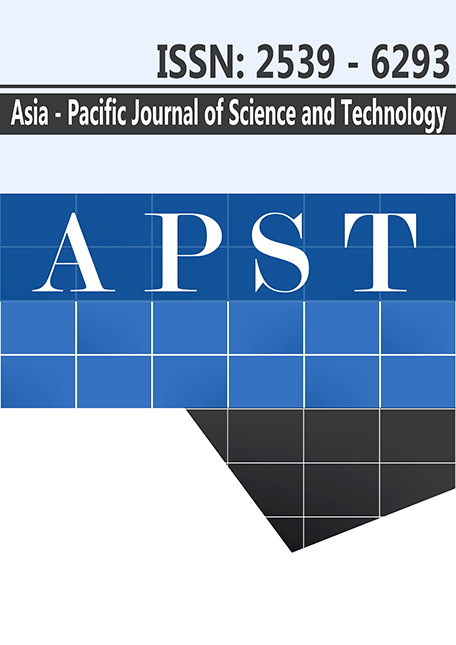Effects of mimosa pigra l. leaf extract on growth behavior of ruellia tuberosa l. and echinochloa crus-galli (l.) p. beauv.
Main Article Content
Abstract
Mimosa pigra L. is an invasive species that can produce some biological compounds to control other plants. This study investigated the potential role of M. pigra L. leaf extracts in plant interference. Aqueous, 80% aqueous methanol (80% MeOH) and methanol (MeOH) extracts at different concentrations of 0, 1, 10 and 100 grams dry weight per liter were prepared and used as treatment solutions to assess their effects on plant growth and the chlorophyll content of two target weed species, Ruellia tuberosa L. and Echinochloa crus-galli (L.) P. Beauv. The experiment was done as a 3 × 4 factorial format with a completely randomized design. It was done under greenhouse conditions. The results revealed that the three different solvent extracts inhibited the growth of both tested weed species and decreased their chlorophyll accumulation. The inhibition increased for each growth parameter with increasing concentrations of each of the various solvent extracts. Among the three extracts, the 80% MeOH and MeOH extracts showed greater efficacy than the aqueous extract. These M. pigra extracts had a phytotoxic potential to control weed growth.
Article Details
References
minuta as a natural herbicide for managing rice weeds. Crop Protection 26, 566-571.
[2] Panuwet, P., Siriwong, W., Prapamontol, T., Ryan, P.B., Fiedler, N., Robson, M.G., Barr, D.B., 2012.
Agricultural pesticide management in Thailand: situation and population health risk. Environmental Science
& Policy 17, 72-81.
[3] Dayan, F.E., Owens, D.K., Duke, S.O., 2012. Rationale for a natural products approach to herbicide
discovery. Pest Management Science 68, 519-528.
[4] Rice, E.L., 1984. Allelopathy. 2nd ed. New York: Academic Press.
[5] Bogatex, R., Gniazdowska, A., Zakrzewska, W., Oracz, K., Gawroński, S.W., 2006. Allelopathic effects of
sunflower extracts on mustard seed germination and seedling growth. Biologia Plantarum 50, 156-158.
[6] Aslam, F., Khalid, A., Matloob, A., Abbas, R.N., Hussain, S., Rasul, F., 2014. Differential allelopathic
activity of Parthenium hysterophorus L. against canary grass and wild oat. Journal of Animal and Plant
Sciences 24, 234-244.
[7] Madany, M.Y.M., Saleh, A.M., 2015. Phytotoxicity of Euphorbia helioscopia L. on Triticum aestivum L.
and Pisum sativum L. Annals of Agricultural Sciences 60, 141-151.
[8] Rizvi, S.J., Rizvi, V., 2000. Allelopathy basic and applied aspects. London: Chapman & Hall; 1992.
[9] Duke SO, Dayan FE, Romagni JG, Rimando AM. Natural products as source of herbicide: current status and
future trends. Weed Research 40, 99-111.
[10] Bais, H.P., Vepachedu, R., Gilroy, S., Callaway, R.M., Vivanco, J.M., 2003. Allelopathy and exotic plant
invasion: from molecules and genes to species interactions. Science. 301, 1377-1380.
[11] Sharma, R., Gupta, R., 2007. Cyperus rotundus extract inhibits acetylcholinesterase activity from animal and
plants as well as inhibits germination and seedling growth in wheat and tomato. Life Sciences 80, 2389-
2392.
[12] Sadia, S., Qureshi, R., Khalid, S., Nayyar, B.G., Zhang, J., 2015. Role of secondary metabolites of wild
marigold in suppression of Johnson grass and Sun spurge. Asian Pacific Journal of Tropical Biomedicine 5,
733-737.
[13] Chengxu, W., Mingxing, Z., Xuhui, C., Bo, Q., 2011. Review on allelopathy of exotic invasive plants.
Procedia Engineering 18, 240-246.
[14] Global Invasive Species Database. [WWW Document].URL https://www.issg.org/database. (accessed 19. 08.
16).
[15] Koodkaew, I., 2015. Effect of Mimosa pigra L. extract on seedling growth and cell viability in Ruellia
tuberosa Linn. King Mongkut's Agricultural Journal 33, 237-241. (Thai).
[16] Arnon, D.I., 1949 Copper enzyme in isolated chloroplast. Polyphenoloxidase in Beta vulgaris. Plant
Physiology 24, 1-15.
[17] Taiz, L., Zeiger, E., 2006. Plant physiology. 4th ed. Sunderland: Sinauer Associates, Inc.
[18] Harborne, J.B., 1998. Phytochemical methods: A guide to modern techniques of plant analysis. 4th ed.
London: Chapman & Hall.
[19] Tiwari, P., Kumar, B., Kaur, M., Kaur, G., Kaur, H., 2011. Phytochemicals screening and extraction: a
review. International Journal of Pharma and Bio Sciences 1, 98-106.
[20] Mecina, G.F., Santos, V.H.M., Andrade, A.R., Dokkedal, A.L., Saldanha, L.L., Silva, L.P., Silva, R.M.G.,
2016. Phytotoxicity of Tridax procumbens L. South African Journal of Botany 102, 130-136.
[21] Rosado-Vallado, M., Brito-Loeza, W., Mena-Rejon, G.J., Quintero-Marmol, E., Flores-Guido, J.S., 2000.
Antimicrobial activity of Fabaceae species used in Yucatan traditional medicine. Fitoterapia 71, 570-573.
[22] Rakotomalala, G., Agard, C., Tonnerre, P., Tesse, A., Derbré, S., Michalet, S., Hamzaoui, J., Rio, M., CarioToumaniantz, C., Richomme, P., Charreau, B., Loirand, G., Pacaud, P., 2013. Extract from Mimosa pigra
attenuates chronic experimental pulmonary hypertension. Journal of Ethnopharmacology 148, 106-116.


